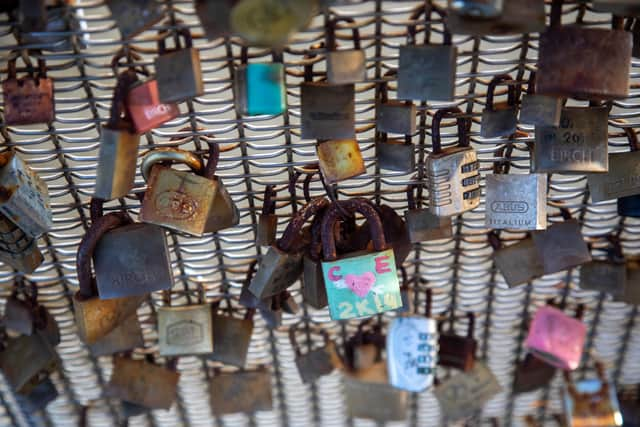Campaign launched to remove hundreds of 'lovelocks' from Bristol harbour bridge
and live on Freeview channel 276
A campaign has been launched to remove hundreds of 'lovelocks' from a bridge - as they are a 'symbol of oppression'.
The petition has been made to remove the padlocks - left by loved-up couples and friends - on the crossing named after a slave.
Advertisement
Hide AdAdvertisement
Hide AdPero's Bridge in Bristol's harbour was named after Pero Jones, an 18th century slave brought to live in the city by his 'owner' after he was purchased at the age of just 12.
Since its construction in 1999, locals have copied the tradition best known from the Pont des Arts bridge in Paris of attaching padlocks to the railings.
They attach heartfelt messages as a symbol of their love for someone. The practice has taken place for years, and while not technically allowed, Bristol City Council have never enforced a ban on the practice - instead removing the locks every few years.
City resident Helen Tierney says that Pero was never granted his freedom - and the thousands of 'hideous' love locks dishonour his memory.
Advertisement
Hide AdAdvertisement
Hide AdIn a petition on 38 Degrees, she is calling on Bristol Mayor Marvin Rees to remove the locks from the bridge which is "weighed down by the very symbols of oppression".
She wrote: "To Marvin Rees, Mayor of Bristol. In the heart of Bristol is a pedestrian bridge crossing the harbour.
"The City Council agreed the name Pero’s Bridge to honour a young enslaved African, Pero Jones, who in the 18th century was sold into slavery aged 12 & brought by his ‘owner’ to live in Bristol.
"Pero was never granted his freedom & died enslaved. A tiny plaque by the bridge tells this story.
Advertisement
Hide AdAdvertisement
Hide Ad"Pero’s Bridge is now defaced with thousands of padlocks, so called ‘lovelocks’ locked on to its structure.


"The keys most likely dropped into the water below. Only a few steps from the bridge is the place where, in 2020, the statue of slave trader Edward Colston was thrown into the harbour.
"I call upon the Mayor & City Councillors of Bristol to remove these hideous padlocks, not symbols of love at all but of oppression down the centuries, of enslaved people chained & padlocked with the keys thrown away, those people disrespected still today in the very place where they should be honoured."
The pedestrian bascule bridge linking Queen Square and Millennium Square also sits a matter of meters from the site of controversial Black Lives Matter protests in 2020.
Advertisement
Hide AdAdvertisement
Hide AdIn that protest, campaigners famously threw a statue of Bristol slave trader Edward Colston into the city harbour just metres from the bridge.
The statue was later recovered and put on exhibition from 4 June to 5 September 2021 at the M Shed museum in Bristol.
Comment Guidelines
National World encourages reader discussion on our stories. User feedback, insights and back-and-forth exchanges add a rich layer of context to reporting. Please review our Community Guidelines before commenting.
